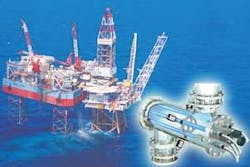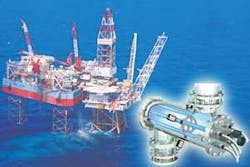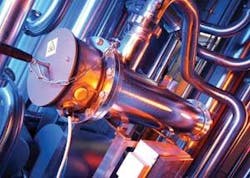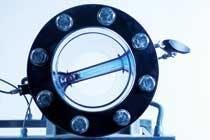UV Disinfection of Downhole Injection Water
by Jon McClean
• Ultraviolet (UV) technology can be used to prevent bacterial contamination of seawater used as downhole injection water in sub-sea drilling operations
Probably the most common technique for enhanced oil recovery is that of using downhole injection water. The quality of the injection water, which is pumped into the oil-bearing strata to force petroleum up, is critical. It must be free from suspended solids and have a low oxygen content to prevent growth of aerobic microorganisms. It’s also important the water is free from bacteria, especially sulfate reducing bacteria (SRB). These bacteria flourish in anaerobic conditions by reducing existing sulfate ions to hydrogen sulphide (H2S) gas. This is highly corrosive and reduces the market value of the oil by increasing its sulphide content, as well as causing pipeline corrosion. It can also be a potential health hazard to personnel. Injection water disinfection is therefore a more suitable alternative to “sweetening” the oil to improve its quality, a costly process.
The Need for Disinfection
As well as corrosion problems, injection of poor quality seawater can lead to obstruction of injection pipe outlets by solid matter or clumps of microorganisms. Several stages of water treatment often are needed to obtain injection water of adequate quality and a combination of physical treatment and disinfection may be used. Typical treatment techniques include screening to remove larger solids and aquatic organisms, filtration to remove smaller particles, deaeration, which removes oxygen, and disinfection which reduces levels of bacteria and other microorganisms.
Installation of UV disinfection systems is typically recommended immediately prior to use, following any other stages in the water treatment process. This ensures there’s minimal opportunity after disinfection for reintroduction of contamination microorganisms. Granular or membrane filters, which often are used to remove fine particles from the water, provide an ideal environment for microbiological growth and post-filtration UV disinfection is recommended to reduce elevated bacterial counts.
Disinfection Using UV
On-line UV disinfection, supplemented by periodic shock dosing using chemical biocides, is one of the most cost-efficient methods of ensuring microbiological contamination in the injection water and associated pipework is minimized.
UV disinfection has been shown to effectively deactivate planktonic SRB in the injection water. Still, because UV has no residual effect, it cannot reduce levels of bacteria colonizing pipework walls. To achieve this, shock dosing with biocides is recommended at regular intervals. UV disinfection dramatically reduces the frequency of chemical dosing and therefore the cost of handling and transporting chemicals.
UV disinfection systems are compact, modular and easy to install into existing water treatment plants. Shock dosing with chemicals doesn’t require the complex monitoring equipment necessary if biocides are used as a primary disinfectant. In addition, UV doesn’t cause formation of chemical disinfection by-products. These can be a problem with continued addition of chemicals causing unwanted and often unforeseen effects in the oil composition.
UV Technology
UV is the part of the electromagnetic spectrum between visible light and X-rays. The specific portion of the UV spectrum between 185-400 nm (also known as UV-C) has a strong germicidal effect, with peak effectiveness at 265 nm. At these wavelengths, UV kills microorganisms by penetrating their cell membranes and damaging the DNA, making them unable to reproduce and effectively destroying them. The UV dose received by a microorganism is dependent on the energy output of the UV lamp, flow rate of the fluid, ability of the fluid to transmit UV and geometry of the treatment chamber.
System Design
A typical UV disinfection system consists of a UV lamp housed in a protective quartz sleeve that’s mounted within a cylindrical stainless steel chamber. The water to be treated enters at one end and passes along the entire length of the chamber before exiting at the other end.
As flow rates increase, chamber size and lamp power output can be increased as required. For larger flows, multiple chambers are used, in series or in parallel, until the required degree of disinfection dosage is reached. The use of high intensity UV lamps is recommended to treat large flow rates without taking up valuable platform space.
Reliable disinfection requires a constant UV dose is applied to the water. Power transformers are available to absorb fluctuations in power supply while maintaining constant power to the UV lamp(s). These fluctuations are common in offshore facilities, being caused by the switching on or off of pumps and other electrical equipment. Power switching options are also available, adjusting the lamp power on-line as the water flow or water quality changes. These options maintain a constant, pre-determined UV dose level while ensuring maximum energy efficiency.
The UV Monitor
In most disinfection systems, an instantaneous means of monitoring effectiveness is desirable. With chemical dosing techniques, disinfection is presumed to have been effective after a certain dose is applied. Similarly with UV, if a minimum dose of UV energy, calculated from the maximum flow rate, can be shown to have reached the outer surface of the treatment chamber (where the UV monitor is situated) then the necessary disinfection has taken place. The UV monitor informs of variations in UV transmission of the fluid, warns of falling UV intensity and constant indication of the disinfection process.
Conclusion
The development of effective monitoring has led to design of reliable automated disinfection systems. To maintain required UV doses under conditions of varying water quality and flow rates, the power output to each UV lamp is constantly adjusted and stand-by UV chambers brought on- or off-line as required. UV systems are also available with industry standard data-logging software which interfaces with existing process control systems, providing information on the flow rate, UV intensity and power output of the UV disinfection system.
About the Author: Jon McClean is president of Aquionics Inc., of Erlanger, KY, and is also divisional managing director of the Halma UV group companies, which include Berson Milieutechniek BV in Holland and Hanovia Ltd. in Great Britain. Contact: 800-925-0440, [email protected] or www.aquionics.com



